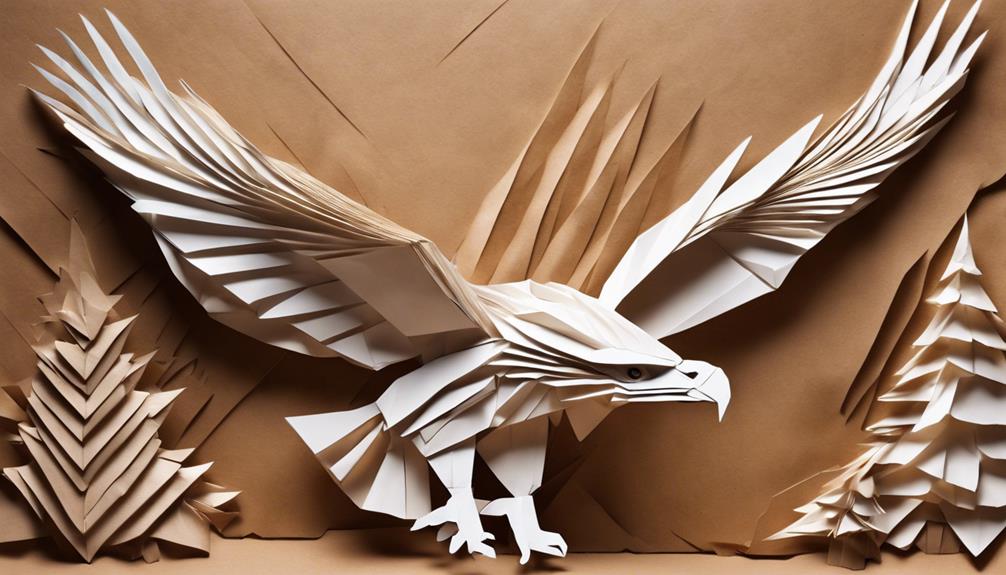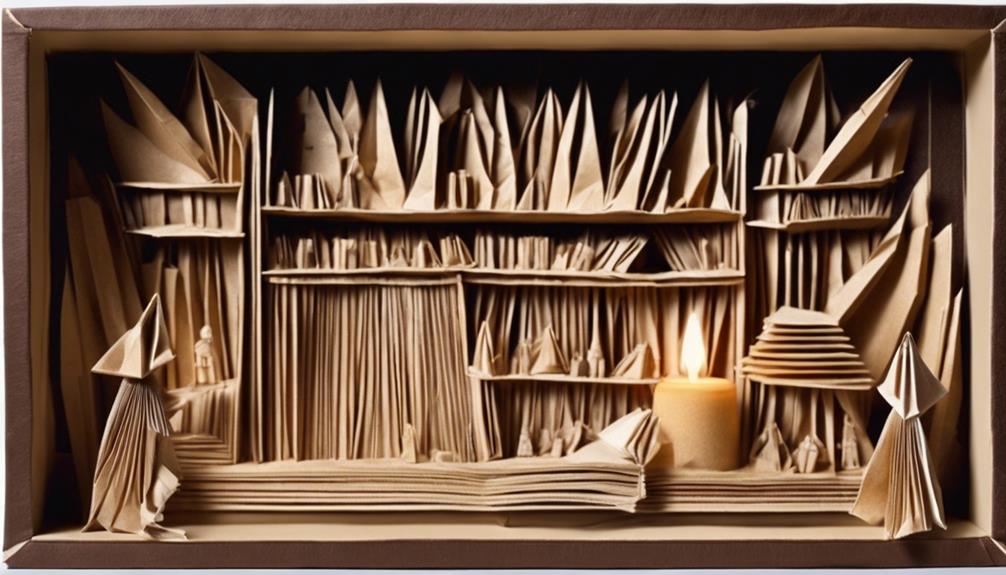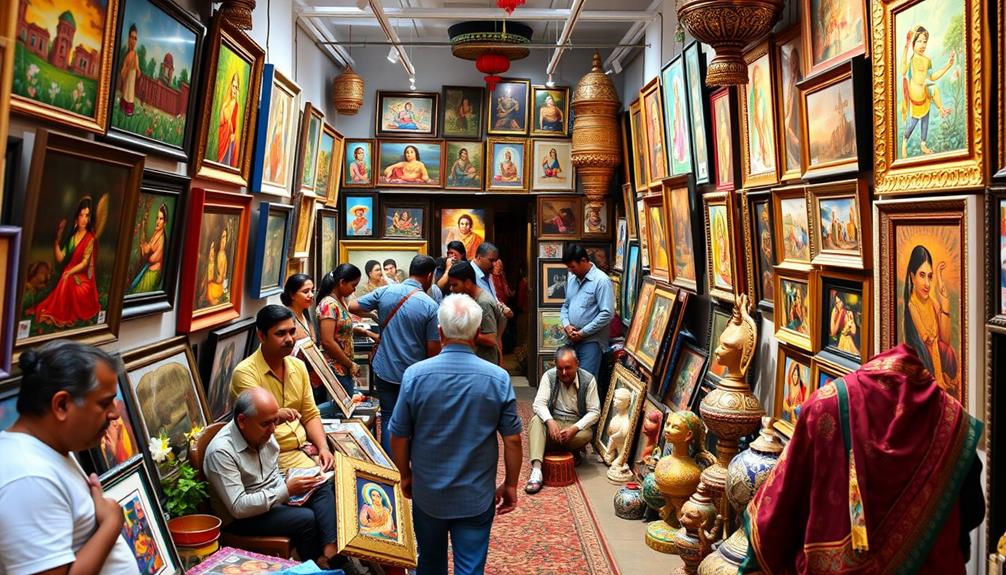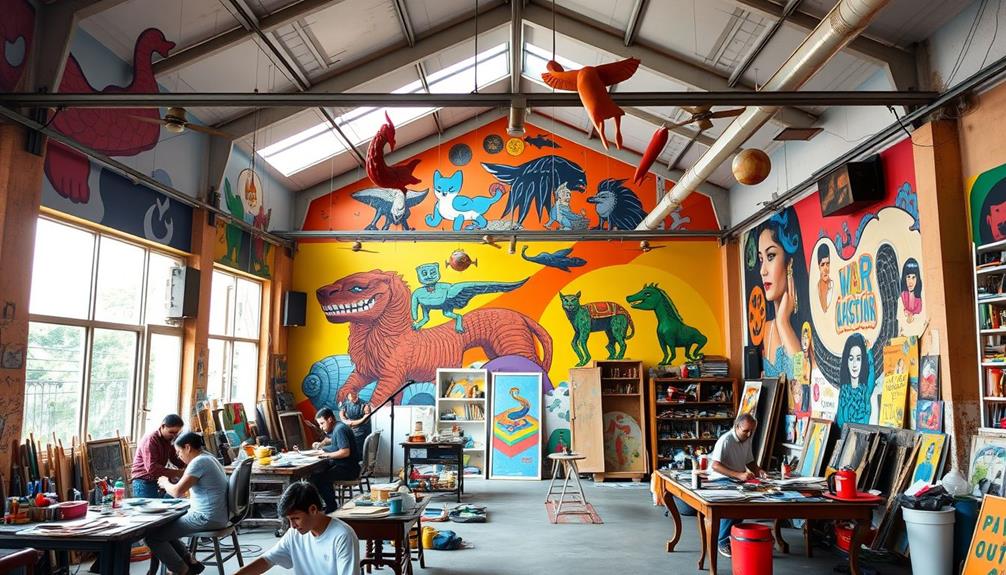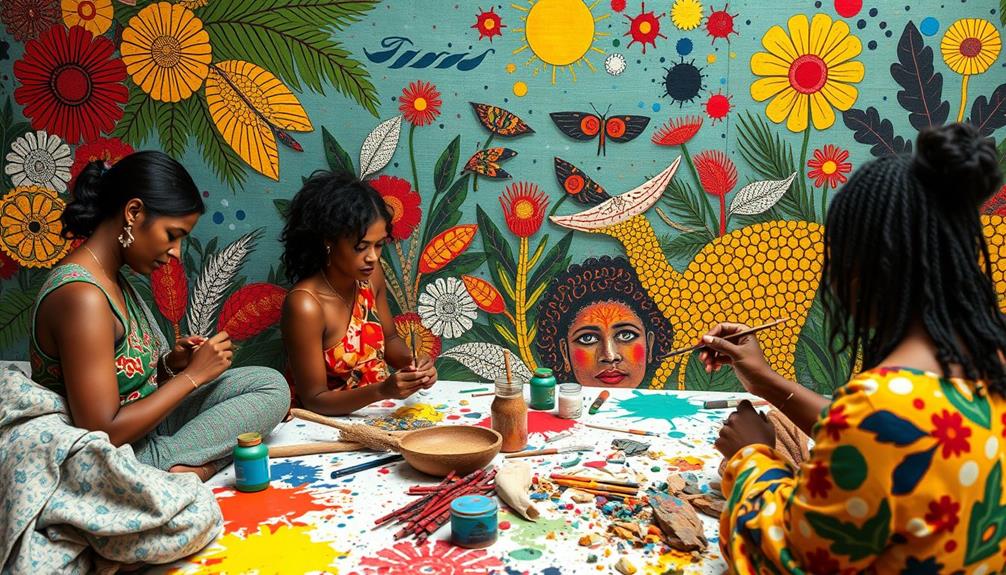India's most bohemian artist was born on September 17, 1913, in Pandharpur, Maharashtra, before moving to Indore in 1919. He began his artistic journey at the Government Sanyogita Ganj Primary School and later honed his skills at the Indore School of Art. Known for his diverse range of styles, from cinema posters to Horse series, he pushed boundaries with a blend of Indian and global influences. Embracing a bohemian lifestyle for inspiration, his work captivated audiences with bold and vibrant expressions. His legacy continues to redefine Indian art and culture, inspiring artists and musicians alike.
Key Takeaways
- Embraced bohemian lifestyle for inspiration, reflecting in unique artistry.
- Blended diverse Indian and global influences in his evolving style.
- Established the Progressive Artists Group in 1947 for experimental art.
- Explored themes of self-examination, death, and family in his work.
- Renowned for his bold and vibrant expression in art, influencing future artists.
Early Life and Influences
Born on September 17, 1913, in Pandharpur, Maharashtra, M.F. Husain's early life in Indore set the stage for his artistic journey. Moving to Indore in 1919 with his father, Husain's upbringing in this city played a significant role in shaping his bohemian approach to art. Starting his artistic endeavors at the Government Sanyogita Ganj Primary School and later honing his skills at the Indore School of Art, Husain's immersion in the vibrant Indian art scene of the time laid the foundation for his future artistic evolution.
His time at the prestigious Sir J. J. School of Art in Bombay further fueled his passion for creativity. Embracing the diverse influences of Indian culture, Husain's early years in Indore instilled in him a deep appreciation for the rich tapestry of Indian art. This early exposure to the intricacies of Indian civilization and artistic traditions would later become prominent themes in his groundbreaking works, solidifying his legacy as a trailblazer in the domain of Indian art.
Artistic Evolution and Style

M.F. Husain's artistic journey was a tapestry woven with unique influences and experimental techniques. His diverse range of styles, from cinema posters to the iconic Horse series, showcased his willingness to push artistic boundaries.
Through bold experiments and collaborations, Husain's evolving style captivated audiences and left a lasting impact on the Indian art scene.
Unique Artistic Influences
Throughout his artistic journey, M.F. Husain's unique style evolved and blended diverse Indian influences with global ambitions, shaping his iconic series and distinct artistic vibe.
Embracing a bohemian lifestyle akin to Montmartre's artistic community, Husain drew inspiration from the Romani people, infusing his works with a sense of wanderlust and cultural exploration. His renowned series, such as the Horse paintings and artworks like Zameen and Between the Spider and the Lamp, reflected this fusion of influences, showcasing a harmonious blend of Indian heritage and global perspectives.
Husain's experimental forays into subjects like Mother Teresa, the British Raj, and Indian epics like the Ramayana and Mahabharata further exemplified his eclectic artistic tastes. Prominent portraits of figures like Indira Gandhi and Urdu poets in the 1980s highlighted his evolving style, characterized by a bold and vibrant expression that resonated with audiences worldwide.
Despite controversies, his artistry remained a reflection of his unwavering commitment to artistic exploration and cultural amalgamation.
Experimental Creative Techniques
Husain's artistic evolution not only showcased a fusion of Indian and global influences but also highlighted his experimentation with creative techniques, reflecting a modern twist on traditional themes.
As a bohemian artist deeply immersed in the world of modern art, Husain's approach was marked by a fearless exploration of new methods and styles. Moving from cinema posters to establishing the Progressive Artists Group in 1947, he embarked on a journey that saw the birth of iconic series like the Horse series in 1954.
His works, such as Zameen (1955) and Between the Spider and the Lamp (1956), explored themes of self-examination, death, family, and urban life with an unprecedented vigor. Husain's unique style seamlessly blended regional Indian influences with global aspirations, crafting pieces that exuded intensity and power.
Through this amalgamation of diverse influences and experimental techniques, Husain's artistry exemplified a modern interpretation of 19th-century art, bridging the gap between local traditions and contemporary perspectives.
Studio Life and Creative Process
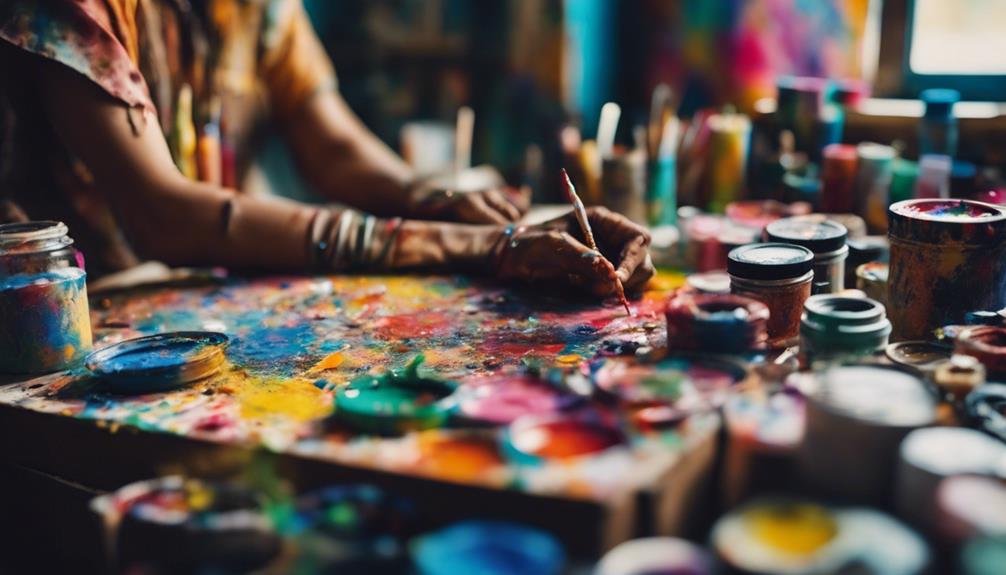
Ratheesh T's studio in southern India serves as the hub for his creative endeavors, where he meticulously crafts his intense and powerful paintings.
Utilizing a variety of inspirational tools, Ratheesh T immerses himself in themes of self-examination, death, family, nature, and urban life, shaping his artistic vision.
Through a detailed artistic workflow, the artist brings to life pieces like 'Divine Death,' a monumental work that showcases his bold and ambitious style.
Studio Setup Insights
How does the artist's studio setup in southern India contribute to the unique blend of regional and global influences in his intense and powerful artistic style?
Ratheesh T's studio, nestled in the serene surroundings of southern India, plays a significant role in shaping his art. The studio reflects a harmonious fusion of regional Indian influences and global aspirations, evident in the themes explored within his paintings.
Ratheesh T explores profound subjects such as self-examination, death, family dynamics, nature, and urban life, all within the confines of his studio space. The dimensions of his painting 'Divine Death,' measuring 79 x 121 inches (200 x 308 cm), highlight the scale of his creative output emanating from this very studio.
It's within this creative sanctuary that Ratheesh T immerses himself in the complexities of contemporary Indian art, aspiring for global recognition through his intense and powerful artistic style.
Inspirational Tools Used
Filled with vibrant colors, eclectic artifacts, and quirky objects, the famous artist's studio reflects his creative sensibility and unique vibe, serving as a hub for inspiration and innovation. This space isn't just a mere workplace but an intellectual sanctuary where the artist immerses himself in a world of artistic exploration.
The walls adorned with his creations and shelves filled with various artistic tools provide a glimpse into his creative process, showcasing a blend of tradition and innovation.
From antique furniture to collectibles from antique markets, the studio's decor is carefully curated to stimulate the artist's intellectual curiosity and spark new ideas. Every item, whether a Gandhara reproduction or a sentimental piece from travels, plays a role in shaping the artist's imaginative landscape.
These inspirational tools act as catalysts for his artistic vision, guiding him towards unique and thought-provoking creations that captivate audiences worldwide.
Artistic Workflow Details
The artist's creative workflow in his vibrant studio involves a dynamic exploration of different styles and techniques to produce unique artworks. Farrukh Shahab's sanctuary is a space filled with colors, eclectic artifacts, and creative chaos, where he immerses himself in a continuous journey of self-expression and reflection.
Drawing inspiration from his surroundings, travels, and everyday experiences, Shahab's process is a blend of experimentation and deep contemplation. His first solo exhibition catapulted him into the limelight, showcasing his ability to blend traditional techniques with a modern twist.
Reminiscent of the bohemian artists who once roamed Montmartre at the turn of the century, Shahab's studio life mirrors a similar creative fervor, fueled by a passion for pushing boundaries and exploring the uncharted territories of art. Within the confines of his studio, time seems to lose its grip as Shahab delves deeper into his work, each piece a reflection of his unwavering dedication to his craft.
Themes and Inspirations

Throughout M.F. Husain's artistic journey, he explored themes ranging from Indian mythology and culture to global politics and social issues, drawing inspiration from a myriad of sources including historical events, literary figures, and diverse cultures. His bohemian approach to art led him to blend traditional Indian motifs with contemporary social commentary, creating a unique visual language that resonated with audiences worldwide. One of his most iconic series, the *Horse* series, symbolizes energy, movement, and freedom, reflecting his deep-rooted interest in social and cultural liberation. Similarly, his *Mahabharata* series delves into the epic tale's characters, conflicts, and moral dilemmas, showcasing his ability to intertwine historical narratives with modern interpretations. Influences from Indian civilization, Arabic culture, and global events are evident in his artistic themes, highlighting his eclectic inspirations and the depth of his creative vision.
| Themes | Inspirations | Symbolism |
|---|---|---|
| Indian mythology | Mother Teresa | Energy, movement, freedom |
| Culture | Historical events | Social and cultural liberation |
| Politics | Literary characters | Moral dilemmas |
Recognition and Criticism

Amid accolades and backlash, Maqbool Fida Husain navigated a tumultuous path of recognition and criticism in his artistic endeavors. His unique style, often deemed bohemian, garnered both praise and scrutiny, shaping his legacy in the art world.
Here are four key points to ponder:
- Prestigious Honors: Husain was honored with the Padma Shri, Padma Bhushan, and Padma Vibhushan for his significant artistic contributions, reflecting official recognition of his talent and impact.
- Controversial Depictions: Criticism arose from his controversial works portraying Hindu deities in a modern and sometimes provocative manner, sparking debates about artistic freedom and cultural sensitivities.
- Legal Issues and Exile: Targeted by right-wing extremists, Husain faced legal challenges that led to his self-exile in Dubai in 2006, highlighting the complexities of art, politics, and society.
- Enduring Influence: Despite the controversies, Husain's artistic experiments continue to resonate, leaving a lasting imprint on Indian art and culture. His work has even reached France, showcasing the global reach of his creative vision.
Global Impact and Influence
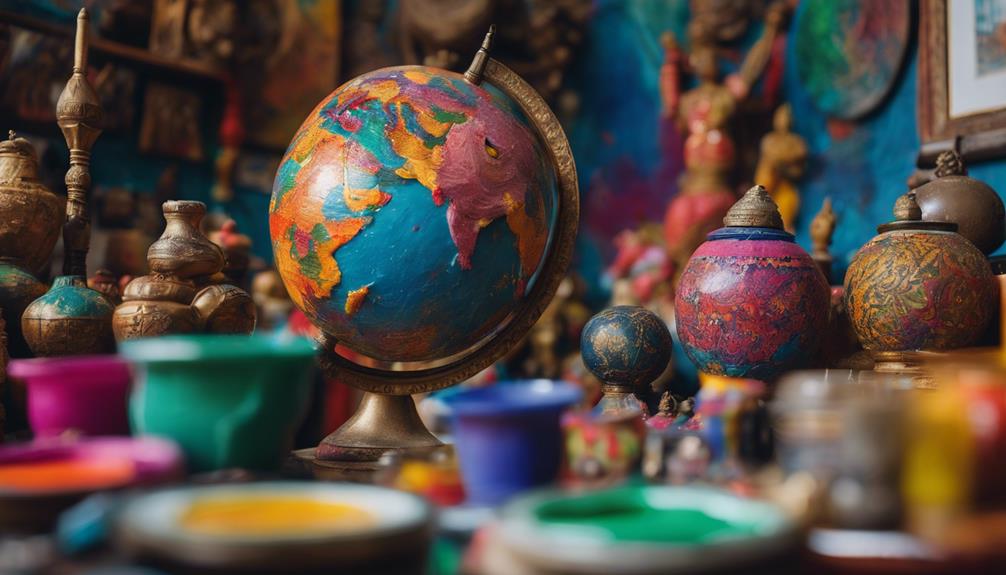
With a global reach that transcends borders, Maqbool Fida Husain's artistic legacy has left an indelible mark on the world stage. His bohemian approach to art captivated audiences worldwide, influencing a generation of artists and musicians.
Through his diverse experiments and unique artistic vision, Husain redefined Indian art and culture, showcasing themes ranging from Indian civilization to Mother Teresa and the British Raj. His collaborations with the Qatari royal family and Indian steel billionaire Lakshmi Mittal highlighted his global influence, solidifying his position as a revered figure in the art world.
Despite facing controversy and legal challenges during his lifetime, Husain's contributions to art continue to be celebrated globally. His series on Indian civilization was posthumously exhibited at the prestigious Victoria and Albert Museum in London, further underscoring his lasting impact.
Artists and musicians around the world continue to draw inspiration from Husain's work, ensuring that his legacy remains influential and enduring on a global scale.
Legacy and Future Prospects
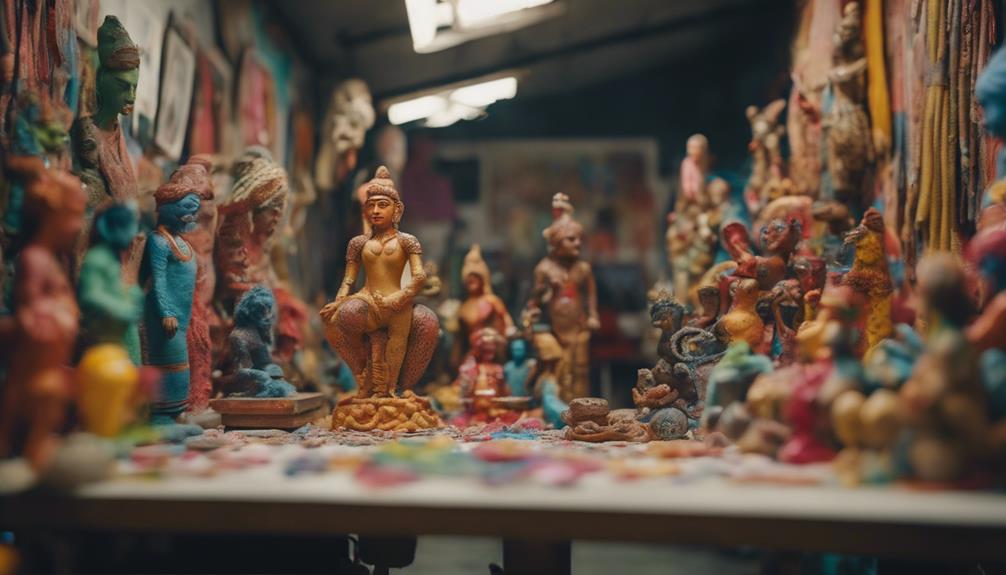
M.F. Husain's enduring legacy as India's most bohemian artist continues to inspire generations of creatives worldwide. His impact on Indian art, diverse experiments, and contributions to culture solidify his place in art history.
The exhibition of his series on Indian civilization at the Victoria and Albert Museum in London underscores his lasting influence. Despite controversies and exile, Husain persisted in his craft, collaborating with notable figures like the Qatari royal family and Lakshmi Mittal.
His accolades, including the Padma Shri, Padma Bhushan, and Padma Vibhushan, affirm his esteemed position in the art world. Notably, Husain's artistic journey, from creating cinema posters in Bombay to iconic series like the *Horse* paintings, showcases his evolution as a true bohemian artist.
- Husain's legacy lies in his lasting impact on Indian art and culture.
- His posthumous exhibition at the Victoria and Albert Museum in London highlights his enduring influence.
- Despite challenges, Husain continued to paint and collaborate with prominent figures.
- Awards like the Padma Shri, Padma Bhushan, and Padma Vibhushan solidify his esteemed status in the art world.
Frequently Asked Questions
What Famous Artists Are Eccentric?
Many famous artists exhibit eccentricities in their work and personal lives. Salvador Dali's surrealism and flamboyant persona are well-known. Vincent van Gogh's tumultuous life and unique artistic style also set him apart. Frida Kahlo's bold self-portraits and political activism further highlight this trend. These artists challenged norms, displayed unconventional behaviors, or explored controversial themes, shaping their legacies as eccentric figures in the art world.
Who Is a Famous Bohemian Artist?
A famous bohemian artist is Maqbool Fida Husain, known as MF Husain. His avant-garde approach to art and unconventional lifestyle defined him as a bohemian figure.
Husain's diverse artworks, such as the iconic Horse series and Indian mythology-inspired pieces, showcased his unique perspective. Despite controversies and exile, his lasting impact on Indian art and culture remains significant.
MF Husain's bohemian spirit continues to inspire artists and art enthusiasts worldwide.
What Was Amrita Sher Gil Known For?
Amrita Sher-Gil was known for her groundbreaking fusion of Western and Indian artistic styles, producing evocative portraits, landscapes, and self-portraits. Her works often explored the lives of Indian peasants and women, portraying their struggles and emotions with depth and empathy.
One of her masterpieces, 'Hill Women,' exemplifies her profound connection to local culture. Sher-Gil's legacy as a pivotal figure in Indian art history continues to inspire generations of artists with her innovative approach and poignant storytelling.
Who Is the Famous Indian Artist of Modern Times Is?
One of the most renowned modern Indian artists is Maqbool Fida Husain, known for his iconic Horse series starting in 1954.
Husain co-founded the Progressive Artists Group in 1947 and received prestigious awards like the Padma Shri, Padma Bhushan, and Padma Vibhushan.
Despite controversies, he continued to paint diverse series on Indian civilization and iconic figures like Mother Teresa and Indira Gandhi.
His artistic legacy has had a lasting impact on Indian art and culture.
Conclusion
To sum up, India's most bohemian artist led a life filled with eccentricity and creativity, leaving a lasting impact on the art world.
Despite facing criticism, their unique style and innovative approach to art have garnered global recognition and influence.
Their legacy continues to inspire future generations of artists to push boundaries and think outside the box.
The artist's unconventional life serves as a reminder that true artistry knows no limits.

